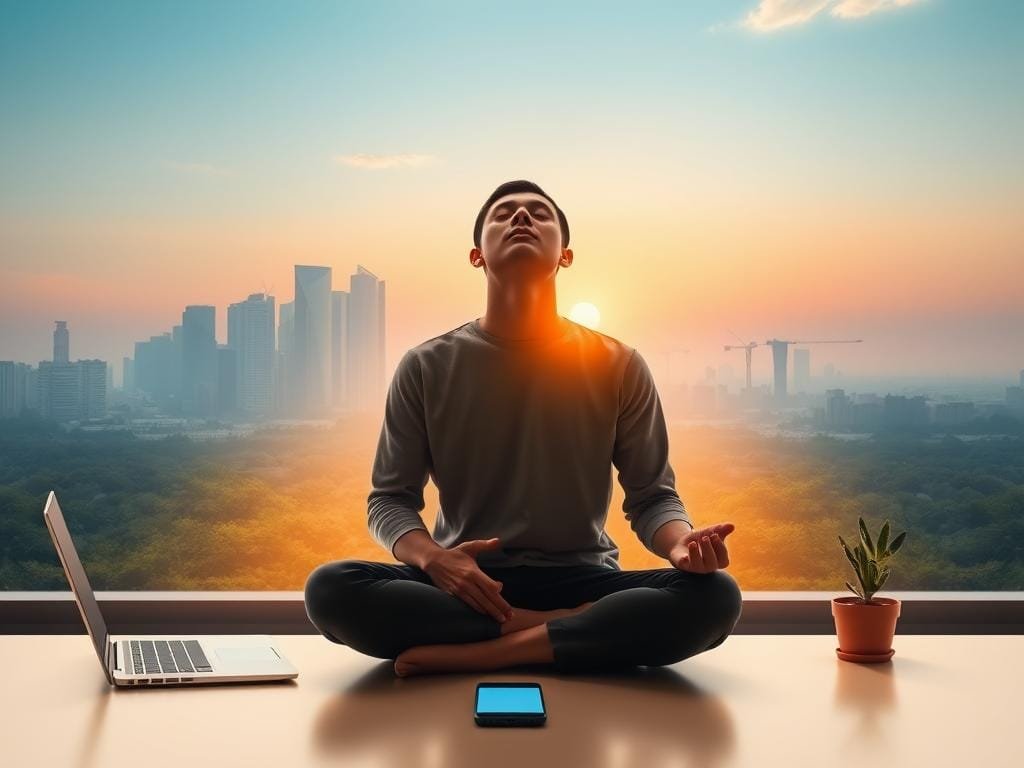In today’s world, you’re hit with endless notifications, emails, and social media updates. Did you know that the average person checks their phone over 150 times per day? This constant checking can make you feel tired, less productive, and overwhelmed.
It’s key to step back and recharge in this digital world. Disconnecting from technology can help you focus better, think clearer, and feel better overall. This is what digital detox is all about.
By taking a break from digital, you can reclaim your time and focus. This leads to a more balanced and fulfilling life.
Table of Contents
Key Takeaways
- Constant connectivity can lead to mental fatigue and decreased productivity.
- Digital detox helps you regain focus and improve mental clarity.
- Disconnecting from technology can enhance overall well-being.
- Taking a digital detox can lead to a more balanced life.
- Reclaiming your time and focus is essential in today’s connected world.
Understanding Digital Detox: What It Means and Why It Matters
Digital detox is about stepping away from devices and digital platforms. In today’s world, it’s important to know why we need it. It helps us find a balance between our digital and real lives.
The Impact of Technology on Daily Life
Technology has changed how we live, work, and talk to each other. But too much of it can lead to technology addiction. This can harm our mental and physical health.
Being always connected can make our attention span shorter and stress levels higher. It can even make us addicted. Learning to manage screen time is essential to avoid these problems.
Too much screen time can cause eye strain, sleep problems, and less physical activity. It can also overwhelm us with too much information. This can make us feel anxious and burnt out.
Signs You Need a Digital Detox
So, how do you know if you need a digital detox? Look out for these signs:
- Feeling anxious or restless when you can’t check your phone or notifications.
- Spending more time on screens than engaging in physical activities or social interactions.
- Noticing a significant decrease in your attention span or ability to focus.
- Experiencing sleep disturbances or eye strain due to prolonged screen time.
If you see yourself in these signs, it’s time for a digital detox. The first step is to admit you need to disconnect and find a better balance in your life.
| Signs | Symptoms | Potential Solutions |
|---|---|---|
| Anxiety without phone | Restlessness, anxiety | Practice mindfulness, engage in physical activities |
| Excessive screen time | Eye strain, sleep disturbances | Implement screen time limits, use blue light filtering glasses |
| Decreased attention span | Difficulty focusing | Engage in activities that promote focus, such as reading or meditation |
By recognizing these signs and understanding technology’s impact, you can start a healthier digital life. A digital detox can help you control your screen time and improve your well-being.
The Benefits of a Digital Detox for Your Well-Being
A digital detox lets you rethink your tech use and boost your digital health. By stepping away from screens, you gain many benefits that make life better.
Improved Mental Clarity and Focus
Less digital noise means improved concentration and better habits at work or school. Without constant alerts, you can dive deeper into tasks. This leads to more done and a feeling of achievement.
Also, a digital detox helps you form healthier tech habits. You become more present and less stressed from always being connected.
Enhanced Relationships with Others
Without your phone, you can talk more and connect with people on a deeper level. This strengthens bonds with family and friends.
Being present also makes you more empathetic and understanding. You build a stronger sense of community and connection.

| Benefits | Pre-Digital Detox | Post-Digital Detox |
|---|---|---|
| Mental Clarity | Distracted, stressed | Focused, calm |
| Relationships | Superficial connections | Deeper, meaningful connections |
| Productivity | Constantly checking notifications | Improved concentration, better work habits |
Planning Your Digital Detox: Steps to Take
Before starting your digital detox, define your goals and plan. Know what you want to achieve, like less screen time or more nature. Clear intentions will guide your journey and keep you focused.
Setting Realistic Goals and Timeframes
To succeed in your digital detox, set achievable goals and timeframes. Decide how long you want it to last and what you aim to achieve. Think about your lifestyle and how much you use digital devices. Be honest with yourself about what you can realistically achieve.
Starting small, like a weekend detox, might be easier than a week. As you get more comfortable, you can extend the time. Set specific goals, like cutting down screen time or spending more time outdoors.
Choosing the Right Approach for You
There are many ways to do a digital detox, and the best one for you depends on your preferences and goals. You might choose a full detox or limit certain devices. The key is to find an approach that you can sustain and meets your objectives.
Think about what you’ll do during your detox. Will you read, journal, practice yoga, or explore nature? Choosing activities that bring you joy and fulfillment will help you stay on track. Also, plan for challenges like digital cravings or work needs.
By planning well, setting realistic goals, and choosing the right approach, you can make the most of your digital detox. This preparation will help you develop online mindfulness and enjoy screen-free living. It will lead to a more balanced and fulfilling life.
Creating a Digital Detox Schedule That Works
Your digital detox journey starts with a schedule that fits your life. A good schedule helps you stick to your goals and enjoy less screen time.
Think about your daily routine and what you like when making your schedule. You can pick short detox times or longer breaks, based on what suits you.
Daily Intervals vs. Extended Detox Periods
Choosing between daily breaks and longer detoxes depends on your goals. Daily breaks mean setting times each day to not use screens, like during meals or before bed. This keeps a balance between tech and other activities.
Longer detoxes, like a weekend or week, mean no digital devices at all. This is great for a deep tech break to recharge and think.
Establishing Tech-Free Zones
Creating tech-free areas in your home or daily life is key. Make places like the dinner table or bedrooms screen-free. This encourages better family time or better sleep.
Setting up these zones helps you form healthier habits and use devices less. For example, a tech-free bedroom can lead to better sleep by avoiding screens before bed.

Using these tips in your life can lead to a more balanced, device-free lifestyle. You’ll see better mental clarity, stronger relationships, and more happiness.
How to Prepare for Your Digital Detox
Getting ready for a digital detox is more than just turning off your devices. It’s about setting yourself up for success. This step is key for a stress-free and rewarding experience.
Informing Friends and Family
Telling your friends and family about your digital detox is important. It helps them understand why you’re not online and stops them from worrying.
Just let them know by sending a group message or talking to them. You could say, “I’m taking a break from my devices to focus on myself and the world around me. I won’t be on social media, and I might not answer messages right away.”
Managing Work and Responsibilities
Work and personal tasks often rely on digital devices. Handling these tasks is a big part of getting ready for your digital detox.
Here are some steps to manage your work and responsibilities:
- Finish any urgent tasks before your detox starts.
- Tell your colleagues and clients about your digital detox plans, if needed.
- Use an auto-response on your email or messaging apps.
| Task | Deadline | Status |
|---|---|---|
| Inform friends and family | 1 day before | Pending |
| Complete urgent work tasks | 1 day before | Pending |
| Set up auto-response on email | 1 day before | Pending |
As digital detox expert, Dr. Cal Newport notes, “The key to a successful digital detox is not just about avoiding technology, but about creating a meaningful and fulfilling life.”
By following these steps and tips, you can have a smooth and rewarding digital detox. Finding a digital balance means making smart choices about how you use technology.
The Role of Mindfulness in Digital Detox
Mindfulness is a powerful tool that complements digital detox. It helps you stay grounded in the present moment. By practicing mindfulness, you can reduce stress and anxiety from technology use. This leads to a more balanced and healthy lifestyle.
Combining mindfulness with digital detox is a strong strategy against technology addiction. Mindfulness makes you more aware of your thoughts and feelings. This makes it easier to resist the urge to constantly check your phone or other devices.
Practicing Mindfulness Techniques
To practice mindfulness during digital detox, start by focusing on your breath. Simple breathing exercises can calm your mind and reduce the urge to check your phone. Try body scan meditation, paying attention to your body and releasing tension.
For more guidance, visit Minimalist Phone’s blog on combining mindfulness with digital. It offers tips and strategies for a successful digital detox experience.
Incorporating Meditation and Breathing Exercises
Adding meditation to your daily routine can enhance your digital detox. Start with short sessions, focusing on your breath or a mantra. Gradually increase the duration as you get more comfortable.
Breathing exercises are also effective for mindfulness. Techniques like diaphragmatic breathing reduce stress and promote relaxation. This makes it easier to stay unplugging from devices.
By integrating mindfulness into your digital detox, you can develop a healthier relationship with technology. This holistic approach supports your journey towards mindful and balanced technology use.
Recommended Activities During a Digital Detox
A digital detox is more than just turning off your devices. It’s about connecting with yourself and the world. You can try different activities that boost digital wellness and help you manage screen time better.
Exploring Nature and Outdoor Activities
Exploring nature is a key part of a digital detox. Being outdoors is good for your body and mind. It can lower stress and make you feel happier. Here are some outdoor activities you might enjoy:
- Hiking or walking in nearby parks or trails
- Cycling or biking through local neighborhoods or bike paths
- Gardening or planting flowers and vegetables
- Having a picnic or simply spending time in a park or by a body of water
Engaging in Creative Hobbies
A digital detox is also a great time to get creative. Creative activities can be calming and rewarding. Here are some ideas:
- Painting or drawing using various mediums
- Writing stories, poetry, or journaling
- Cooking or baking new recipes
- Photography using a film camera or instant camera
For more ideas on starting a healthy lifestyle, including digital detox, you can visit Boost Healthy Life for additional resources and tips.
| Activity Type | Examples | Benefits |
|---|---|---|
| Outdoor Activities | Hiking, Cycling, Gardening | Reduces stress, improves mood, increases physical activity |
| Creative Hobbies | Painting, Writing, Cooking | Enhances creativity, provides therapeutic benefits, fosters personal growth |
Overcoming Challenges During Your Digital Detox
Overcoming digital detox challenges needs willpower, strategy, and online mindfulness. You’ll face many obstacles on this journey. But, with the right mindset, you can overcome them.
Dealing with Digital Cravings
Managing digital cravings is a big challenge. The urge to check your phone or social media can be strong. But, there are ways to handle it.
Use mindfulness techniques to stay in control. Mindfulness helps you recognize when you’re checking devices out of habit. It keeps you present and focused.
- Engage in physical activities to distract yourself from digital cravings.
- Keep a journal to record your feelings and thoughts, helping you process your emotions without reaching for your devices.
- Find alternative hobbies that bring you joy and keep your mind occupied.
Staying Motivated and Committed
Staying motivated is key to a successful digital detox. Remember why you started. Let that motivation guide you.
To stay committed, set small, achievable goals. Celebrating these milestones boosts your dedication to screen-free living.

By understanding challenges and using effective strategies, you can confidently navigate your digital detox. You’ll come out stronger and more resilient.
Reintroducing Technology Mindfully
After a digital detox, it’s key to return to technology with care. This ensures you keep the mental clarity and focus you gained. It’s about making sure your return to digital life doesn’t spoil the progress you made.
To find a digital balance, you must be careful about how you bring technology back. Think about your digital habits before the detox. Decide which ones you want to keep or change.
Establishing Healthy Tech Habits
Creating good tech habits is vital when you start using technology again. Set clear goals for how you’ll use technology. For example, you might limit screen time to certain hours or have device-free times.
Look for resources to help you keep a healthy tech relationship. For more tips, check out this article on digital detox challenges.
Setting Boundaries for Social Media Use
Social media can be distracting and stressful. When you start using technology again, set limits for social media. You might only check it at certain times or avoid certain platforms.
Being mindful of your tech use and setting boundaries helps keep the device-free lifestyle benefits. This way, you can enjoy a healthier digital life.
Success Stories: Real Experiences with Digital Detox
Stepping away from digital can really improve your mental clarity and productivity. Many people have seen big changes in their lives after trying digital detox.
Personal Testimonials and Transformations
People who try digital detox often see big changes. Sarah, a marketing executive, did a 30-day detox. She said it helped her focus more and feel less stressed. You can read more about her story on Shelley Paulson’s blog.
John also shared his experience. After detox, he felt more connected with family and friends. He said setting tech boundaries is key to a good work-life balance.

Insights from Experts on Mindful Tech Use
Experts say being mindful with tech is important. Dr. Jane Smith, a digital wellness expert, advises checking your tech use often. This helps find ways to use it better.
| Expert Advice | Benefit |
|---|---|
| Regularly assess technology use | Identify areas for improvement |
| Set boundaries with technology | Improve work-life balance |
| Practice mindfulness | Enhance mental clarity and focus |
Using these tips can help you have a healthier tech relationship. Enjoy the benefits of digital detox in your life.
Long-Term Strategies for Sustaining a Healthy Digital Lifestyle
Keeping a healthy digital lifestyle takes effort and dedication. You need to be careful about how much time you spend on screens. This means setting limits and thinking about how technology fits into your day.
Building a Balanced Tech Life
Focus on digital wellness to get the most out of tech without the downsides. Taking breaks from screens and doing things that are good for your mind and body helps. This keeps you sharp and productive.
Regular Check-Ins
It’s important to check your digital habits often and make changes if needed. This keeps you on the right path and ensures tech supports your well-being. By making smart choices, you can keep a healthy digital life that improves your life.

